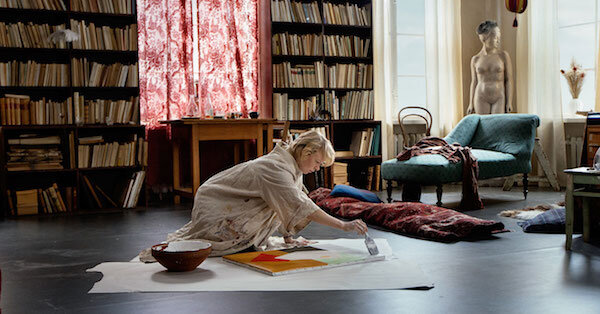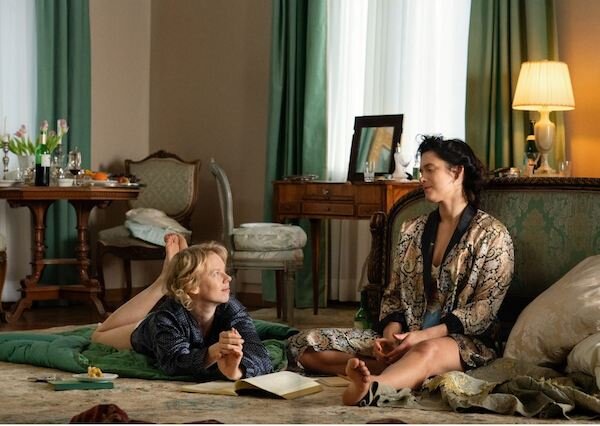Tove Jansson is arguably the most famous contemporary Scandinavian illustrator and writer, beloved for her creation of the Moomins. Her stories about these hippo-like creatures have captivated adults and children alike, and have been translated in over 50 languages. Director Zadia Bergroth illuminates the less explored parts of Jansson’s creativity between 1944 and 1956, including her bisexuality, and why this lustful drive for new encounters gave her the confidence to pursue her drawings.
Illustrator and writer Tove Jansson (Alma Pöysti) is toiling away painting a large canvas of a generic household interior, glancing apathetically as she adds details to the piece. Her spacious, airy apartment is worn to the bone – but for an artist, having her own studio is a luxury in itself. Her real passion lies hidden between layers of paper tucked inside books, keeping safe her private drawings of mystical, hippo-like creatures. While art is a core part of her world, she also seeks out pockets of excitement in other areas of her life. From infatuations with different lovers to wine-soaked nights out dancing, she gravitates towards emotionally fulfilling experiences free from constraints. This hedonistic philosophy emerges in her Moomin stories, in which the characters ponder the existential parts of life yet also revel in joyous activities, just like their creator.
The film documents two of Tove’s early relationships in this period; one of burning passion, and the other of profound companionship. The former is with theatre director Vivica Bandler (Krista Kosonen), and the other with the married politician and philosopher Atos Wirtanen (Shanti Roney). Vivica, daughter of Helsinki’s mayor and also married to Kurt Bandler, makes evident that she and Tove must keep their affair under wraps – a source of excitement for them both. With Atos, there is a kindness in their kinship, and both his support for her work and her affair with Vivica give Tove the confidence to engage in both relationships without jealousy or tension. This freedom to love who she chooses gives her the assurance to take bold steps in her personal and professional life; eventually the Moomins become less of a secret, more at the centre of her artistic focus.
Bergroth’s exploration cuts each scene into two sections, firstly with Tove usually engaged in conversation with friends or spending time with her lovers, and then with her back in the studio painting or drawing. After a night of passion, her work usually depicts bright, colourful portraits, but if it’s been tense or difficult, the paintings are bleak and less structured. Tove dedicates more time to the Moomin stories after spending time with either partner, and she writes them up as characters in her book. Atos becomes Snufkin, a companion of the book’s protagonist Moomintroll, whom she sketches out the morning after a dinner party with the philosopher. His character is wise, and talks wistfully about adventures; alluding to Tove and Atos’ decision to be in an open relationship, which gives them the freedom they need. Soon after, Tove spends the night with Vivica, and as they lie smoking in the morning light, Vivica playfully comments on Tove’s mumbling and giggling, calling her a ‘Mymble’. Back in the studio, Tove wanders over to her desk, and the shot focuses on her choosing a pencil over a paintbrush, and she draws two elvish creatures – Thingumy and Bob – sat around a campfire talking in their own secret, nonsensical language. Their story mirrors Vivica and Tove, two inquisitive creatures, merrily lost in their own bubble. As she sketches, Tove murmurs, “It isn’t clear to everyone but the main thing is they understand each other.” Homosexuality was illegal in Finland until 1971, so while Tove and Vivica could not openly be together, Tove’s love letters came in the form of her stories.
This subtle display of affection for Vivica and Atos through Tove’s work demonstrates the crucial role vulnerability plays in both art and sex; sharing both your creative endeavours and your body with someone requires trust. As Tove becomes more respected as a creator in the art world, she takes a bold step in her expression of love towards Vivica. She is commissioned to paint a wall mural in Helsinki City Hall and places Vivica dancing with a man at the center, but also paints herself seated just in front of her. This secretive portrayal of queer love in a political building reflects Tove’s growing confidence. As time passes, her affair with Atos falls into platonic friendship, and Vivica becomes more interested in chasing other women than committing fully to Tove. This heartache proves to Tove that she no longer needs Vivica’s validation, and is able to solely pursue what she truly loves – her Moomins. She releases her anger by smashing up firewood in the studio while sobbing, and after collecting herself, rearranges the studio so her writing desk is the center of the room instead of the easel for the paintings. She restructures her artistic space to fully focus on her drawings; deciding where her commitments now lie.
These moments of rejection and growth are natural occurrences within our public and private lives. For Tove, while these early romantic relationships may have faded, her time with them is immortalised through the Moomin books. Years later, during a trip to Paris, Tove is introduced to graphic artist Tuulikki Pietilä at a party, where they affectionately watch each other dance. While in the city, she awkwardly encounters Vivica, who tries to win her back, but Tove walks away, having developed the confidence to know that Vivica will never reciprocate the degree of love and commitment she wants in her life. Instead, she ends up inviting Tuulikki to the studio in Helsinki, who shyly brings Tove baked goods and can’t keep her eyes off her. Tove shares the painting she’s been working on, an unfinished self-portrait titled The Beginner. It feels like a definitive moment for Tove, in starting a new chapter with someone who is willing to openly exist as a queer couple, and embraces her as she is.
The film celebrates Tove’s Jansson’s creativity and sexuality, the power she derives from this and how it comes to inform the art she creates. Bergroth identifies that the Moomins were able to become the focus of the artist’s career and work because of her relationships with Vivica and Atos. They were more than just her lovers: they were the first people she trusted with her drawings. Tove’s passion for her work, her friendships and her partners became intertwined, which concludes how important happiness and love were for her, and that her approach to life was always playful and with a glint of trouble in her eye.
Elle Haywood is a freelance film critic & programmer for Vague Visages, The Final Girls, Take One Magazine, Film Stories, JumpCut Online, Film Daze, and Next Best Picture. She is the Associate Editor at Take One Magazine and studying for a Curation Masters Degree at the National Film and Television School. She identifies as a bisexual woman.



